NCERT Solution for Class 9 Mathematics Chapter 6 - Lines And Angles Page/Excercise 6.1
Question 1
In the given figure, lines AB and CD intersect at O. If  AOC+
AOC+ BOE=70� and
BOE=70� and  BOD=40� find
BOD=40� find  BOE and reflex
BOE and reflex  COE.
COE. 
 AOC+
AOC+ BOE=70� and
BOE=70� and  BOD=40� find
BOD=40� find  BOE and reflex
BOE and reflex  COE.
COE. 
Solution 1
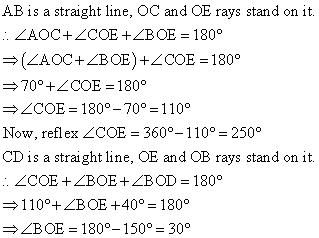
Question 2
In the given figure, lines XY and MN intersect at O. If POY = 90o and a:b = 2 : 3, find c.
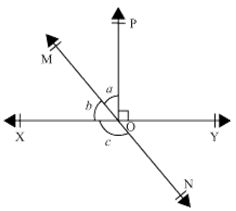

Solution 2
Let common ratio between a and b is x, a = 2x and b = 3x.
XY is a straight line, OM and OP rays stands on it.
XOM + MOP + POY = 180� b + a + POY = 180�
3x + 2x + 90� = 180�
5x = 90�
x = 18�
a = 2x
= 2 * 18
= 36�
b = 3x
= 3 * 18
= 54�
Now, MN is a straight line. OX ray stands on it.
 b +
b +  c = 180�
c = 180�
54� +  c = 180�
c = 180�
 c = 180�
c = 180� c = 180� � 54� = 126�
c = 180� � 54� = 126�  c = 126�
c = 126�
Question 3
In the given figure,  PQR =
PQR =  PRQ, then prove that
PRQ, then prove that  PQS =
PQS =  PRT.
PRT. 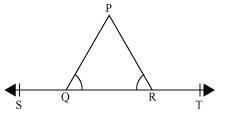
 PQR =
PQR =  PRQ, then prove that
PRQ, then prove that  PQS =
PQS =  PRT.
PRT. 
Solution 3
In the given figure, ST is a straight line and QP ray stand on it.

 PQS +
PQS +  PQR = 180� (Linear Pair)
PQR = 180� (Linear Pair)  PQR = 180� -
PQR = 180� -  PQS (1)
PQS (1)
 PRT +
PRT +  PRQ = 180� (Linear Pair)
PRQ = 180� (Linear Pair)
 PRQ = 180� -
PRQ = 180� -  PRT (2)
PRT (2)
Given that PQR =
PQR =  PRQ. Now, equating equations (1) and (2), we have
PRQ. Now, equating equations (1) and (2), we have
180� - PQS = 180� -
PQS = 180� -  PRT
PRT
 PQS =
PQS =  PRT
PRT
 PQS +
PQS +  PQR = 180� (Linear Pair)
PQR = 180� (Linear Pair)  PQR = 180� -
PQR = 180� -  PQS (1)
PQS (1) PRT +
PRT +  PRQ = 180� (Linear Pair)
PRQ = 180� (Linear Pair) PRQ = 180� -
PRQ = 180� -  PRT (2)
PRT (2)Given that
 PQR =
PQR =  PRQ. Now, equating equations (1) and (2), we have
PRQ. Now, equating equations (1) and (2), we have180� -
 PQS = 180� -
PQS = 180� -  PRT
PRT PQS =
PQS =  PRT
PRT
Question 4
In the given figure, if x + y = w + z then prove that AOB is a line. 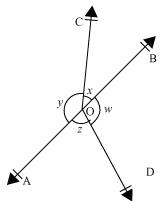

Solution 4
We may observe that
x + y + z + w = 360� (Complete angle)
It is given that
x + y = z + w
 x + y + x + y = 360�
x + y + x + y = 360�
2(x + y) = 360�
x + y = 180�
Since x and y form a linear pair, thus AOB is a line.
x + y + z + w = 360� (Complete angle)
It is given that
x + y = z + w
2(x + y) = 360�
x + y = 180�
Since x and y form a linear pair, thus AOB is a line.
Question 5
In the given figure, POQ is a line. Ray OR is perpendicular to line PQ. OS is another ray lying between rays OP and OR. Prove that 
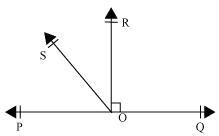

Solution 5
Given that OR  PQ
PQ 
 POR = 90�
POR = 90�  POS +
POS +  SOR = 90�
SOR = 90�  ROS = 90� -
ROS = 90� -  POS ... (1)
POS ... (1)  QOR = 90� (As OR
QOR = 90� (As OR  PQ)
PQ)  QOS -
QOS -  ROS = 90�
ROS = 90�  ROS =
ROS =  QOS - 90� ... (2) On adding equations (1) and (2), we have 2
QOS - 90� ... (2) On adding equations (1) and (2), we have 2  ROS =
ROS =  QOS -
QOS -  POS
POS 
 PQ
PQ  POR = 90�
POR = 90�  POS +
POS +  SOR = 90�
SOR = 90�  ROS = 90� -
ROS = 90� -  POS ... (1)
POS ... (1)  QOR = 90� (As OR
QOR = 90� (As OR  PQ)
PQ)  QOS -
QOS -  ROS = 90�
ROS = 90�  ROS =
ROS =  QOS - 90� ... (2) On adding equations (1) and (2), we have 2
QOS - 90� ... (2) On adding equations (1) and (2), we have 2  ROS =
ROS =  QOS -
QOS -  POS
POS
Question 6
It is given that  XYZ = 64� and XY is produced to point P. Draw a figure from the given information. If ray YQ bisects
XYZ = 64� and XY is produced to point P. Draw a figure from the given information. If ray YQ bisects  ZYP, find
ZYP, find  XYQ and reflex
XYQ and reflex  QYP.
QYP.
 XYZ = 64� and XY is produced to point P. Draw a figure from the given information. If ray YQ bisects
XYZ = 64� and XY is produced to point P. Draw a figure from the given information. If ray YQ bisects  ZYP, find
ZYP, find  XYQ and reflex
XYQ and reflex  QYP.
QYP.
Solution 6
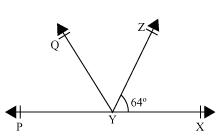 Given that line YQ bisects
Given that line YQ bisects  PYZ.
PYZ.Hence,
 QYP =
QYP =  ZYQ
ZYQ Now we may observe that PX is a line. YQ and YZ rays stand on it.
 XYZ +
XYZ +  ZYQ +
ZYQ +  QYP = 180�
QYP = 180�  64� + 2
64� + 2 QYP = 180�
QYP = 180�  2
2 QYP = 180� - 64� = 116�
QYP = 180� - 64� = 116� 
 QYP = 58� Also,
QYP = 58� Also,  ZYQ =
ZYQ =  QYP = 58� Reflex
QYP = 58� Reflex  QYP = 360o - 58o = 302o
QYP = 360o - 58o = 302o  XYQ =
XYQ =  XYZ +
XYZ +  ZYQ = 64o + 58o = 122o
ZYQ = 64o + 58o = 122oNCERT Solution for Class 9 Mathematics Chapter 6 - Lines And Angles Page/Excercise 6.2
Question 1
In the given figure, find the values of x and y and then show that



Solution 1
We may observe that
50� + x = 180� (Linear pair)
x = 130� ... (1)
Also, y = 130� (vertically opposite angles)
As x and y are alternate interior angles for lines AB and CD and also measures of these angles are equal to each other, so line AB || CD
50� + x = 180� (Linear pair)
x = 130� ... (1)
Also, y = 130� (vertically opposite angles)
As x and y are alternate interior angles for lines AB and CD and also measures of these angles are equal to each other, so line AB || CD
Question 2
In the given figure, if AB || CD, CD || EF and y: z = 3: 7, find x. 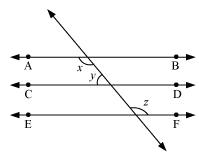

Solution 2
Given that AB || CD and CD || EF  AB || CD || EF (Lines parallel to a same line are parallel to each other) Now we may observe that
AB || CD || EF (Lines parallel to a same line are parallel to each other) Now we may observe that
x = z (alternate interior angles) ... (1)
Given that y: z = 3: 7
Let common ratio between y and z be a
 y = 3a and z = 7a
y = 3a and z = 7a
Also x + y = 180� (co-interior angles on the same side of the transversal) z + y = 180� [Using equation (1)] 7a + 3a = 180� 10a = 180� a = 18�
 x = 7 a = 7
x = 7 a = 7  18� = 126�
18� = 126�
x = z (alternate interior angles) ... (1)
Given that y: z = 3: 7
Let common ratio between y and z be a
Also x + y = 180� (co-interior angles on the same side of the transversal) z + y = 180� [Using equation (1)] 7a + 3a = 180� 10a = 180� a = 18�
 18� = 126�
18� = 126�
Question 3
In the given figure, If AB || CD, EF  CD and
CD and  GED = 126�, find
GED = 126�, find  AGE,
AGE,  GEF and
GEF and  FGE.
FGE. 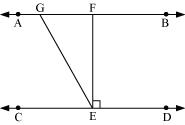
 GED = 126�, find
GED = 126�, find  AGE,
AGE,  GEF and
GEF and  FGE.
FGE. 
Solution 3
It is given that
AB || CD EF CD GED = 126�
CD GED = 126�

 GEF +
GEF +  FED = 126�
FED = 126� 
 GEF + 90� = 126�
GEF + 90� = 126�

 GEF = 36�
GEF = 36�
Now, AGE and
AGE and  GED are alternate interior angles
GED are alternate interior angles 
 AGE =
AGE =  GED = 126� But
GED = 126� But  AGE +
AGE + FGE = 180� (linear pair)
FGE = 180� (linear pair)  126� +
126� +  FGE = 180�
FGE = 180� 
 FGE = 180� - 126� = 54�
FGE = 180� - 126� = 54� 
 AGE = 126�,
AGE = 126�,  GEF = 36�,
GEF = 36�,  FGE = 54�
FGE = 54�
AB || CD EF
 CD GED = 126�
CD GED = 126�
 GEF +
GEF +  FED = 126�
FED = 126� 
 GEF + 90� = 126�
GEF + 90� = 126� 
 GEF = 36�
GEF = 36�Now,
 AGE and
AGE and  GED are alternate interior angles
GED are alternate interior angles 
 AGE =
AGE =  GED = 126� But
GED = 126� But  AGE +
AGE + FGE = 180� (linear pair)
FGE = 180� (linear pair)  126� +
126� +  FGE = 180�
FGE = 180� 
 FGE = 180� - 126� = 54�
FGE = 180� - 126� = 54�  AGE = 126�,
AGE = 126�,  GEF = 36�,
GEF = 36�,  FGE = 54�
FGE = 54�
Question 4
In the given figure, if PQ || ST,  PQR = 110� and
PQR = 110� and  RST = 130�, find
RST = 130�, find  QRS.
QRS. 
 PQR = 110� and
PQR = 110� and  RST = 130�, find
RST = 130�, find  QRS.
QRS. 
Solution 4
 Let us draw a line XY parallel to ST and passing through point R.
Let us draw a line XY parallel to ST and passing through point R. PQR +
PQR +  QRX = 180� (co-interior angles on the same side of transversal QR)
QRX = 180� (co-interior angles on the same side of transversal QR) 110� +
110� +  QRX = 180�
QRX = 180�
 QRX = 70�
QRX = 70�Now,
 RST +
RST + SRY = 180� (co-interior angles on the same side of transversal SR)
SRY = 180� (co-interior angles on the same side of transversal SR)130� +
 SRY = 180�
SRY = 180� SRY = 50�
SRY = 50�XY is a straight line. RQ and RS stand on it.
 QRX +
QRX +  QRS +
QRS +  SRY = 180�
SRY = 180� 70� +
 QRS + 50� = 180�
QRS + 50� = 180� QRS = 180� - 120� = 60�
QRS = 180� - 120� = 60�
Question 5
In the given figure, if AB || CD,  APQ = 50� and
APQ = 50� and  PRD = 127�, find x and y.
PRD = 127�, find x and y.

 APQ = 50� and
APQ = 50� and  PRD = 127�, find x and y.
PRD = 127�, find x and y.
Solution 5
 APR =
APR =  PRD (alternate interior angles)
PRD (alternate interior angles)50� + y = 127�
y = 127� - 50�
y = 77�
Also
 APQ =
APQ =  PQR (alternate interior angles)
PQR (alternate interior angles)50� = x
 x = 50� and y = 77�
x = 50� and y = 77�
Question 6
In the given figure, PQ and RS are two mirrors placed parallel to each other. An incident ray AB strikes the mirror PQ at B, the reflected ray moves along the path BC and strikes the mirror RS at C and again reflects back along CD. Prove that AB || CD. 

Solution 6
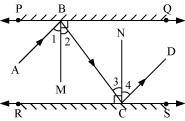 Let us draw BM
Let us draw BM  PQ and CN
PQ and CN  RS.
RS. As PQ || RS
So, BM || CN
Thus, BM and CN are two parallel lines and a transversal line BC cuts them at B and C respectively.
 2 =
2 =  3 (alternate interior angles) But
3 (alternate interior angles) But  1 =
1 =  2 and
2 and  3 =
3 =  4 (By laws of reflection)
4 (By laws of reflection)  1 =
1 =  2 =
2 =  3 =
3 =  4 Now,
4 Now,  1 +
1 +  2 =
2 =  3 +
3 +  4
4  ABC =
ABC =  DCB But, these are alternate interior angles
DCB But, these are alternate interior angles NCERT Solution for Class 9 Mathematics Chapter 6 - Lines And Angles Page/Excercise 6.3
Question 1
In the given figure, sides QP and RQ of  PQR are produced to points S and T respectively. If
PQR are produced to points S and T respectively. If  SPR = 135� and
SPR = 135� and  PQT = 110�, find
PQT = 110�, find  PRQ.
PRQ. 
 PQR are produced to points S and T respectively. If
PQR are produced to points S and T respectively. If  SPR = 135� and
SPR = 135� and  PQT = 110�, find
PQT = 110�, find  PRQ.
PRQ. 
Solution 1
Given that
 SPR = 135� and
SPR = 135� and  PQT = 110�
PQT = 110�
Now, SPR +
SPR +  QPR = 180� (linear pair angles)
QPR = 180� (linear pair angles)
 135� +
135� +  QPR = 180�
QPR = 180�

 QPR = 45�
QPR = 45�
Also, PQT +
PQT +  PQR = 180� (linear pair angles)
PQR = 180� (linear pair angles)
 110� +
110� +  PQR = 180�
PQR = 180�

 PQR = 70�
PQR = 70�
As we know that sum of all interior angles of a triangle is 180�, so, for PQR
PQR
 QPR +
QPR +  PQR +
PQR +  PRQ = 180�
PRQ = 180�
 45� + 70� +
45� + 70� +  PRQ = 180�
PRQ = 180�

 PRQ = 180� - 115�
PRQ = 180� - 115�

 PRQ = 65�
PRQ = 65�
 SPR = 135� and
SPR = 135� and  PQT = 110�
PQT = 110�Now,
 SPR +
SPR +  QPR = 180� (linear pair angles)
QPR = 180� (linear pair angles) 135� +
135� +  QPR = 180�
QPR = 180� 
 QPR = 45�
QPR = 45� Also,
 PQT +
PQT +  PQR = 180� (linear pair angles)
PQR = 180� (linear pair angles) 110� +
110� +  PQR = 180�
PQR = 180�
 PQR = 70�
PQR = 70� As we know that sum of all interior angles of a triangle is 180�, so, for
 PQR
PQR  QPR +
QPR +  PQR +
PQR +  PRQ = 180�
PRQ = 180�  45� + 70� +
45� + 70� +  PRQ = 180�
PRQ = 180� 
 PRQ = 180� - 115�
PRQ = 180� - 115�
 PRQ = 65�
PRQ = 65�
Question 2
In the given figure,  X = 62�,
X = 62�,  XYZ = 54�. If YO and ZO are the bisectors of
XYZ = 54�. If YO and ZO are the bisectors of  XYZ and
XYZ and  XZY respectively of
XZY respectively of  XYZ, find
XYZ, find  OZY and
OZY and  YOZ
YOZ 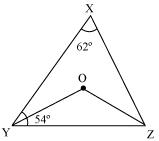
 X = 62�,
X = 62�,  XYZ = 54�. If YO and ZO are the bisectors of
XYZ = 54�. If YO and ZO are the bisectors of  XYZ and
XYZ and  XZY respectively of
XZY respectively of  XYZ, find
XYZ, find  OZY and
OZY and  YOZ
YOZ 
Solution 2
As we know that sum of all interior angles of a triangle is 180�, so for  XYZ
XYZ
 X +
X +  XYZ +
XYZ +  XZY = 180�
XZY = 180�
62� + 54� + XZY = 180�
XZY = 180�
 XZY = 180� - 116�
XZY = 180� - 116�
 XZY = 64�
XZY = 64�  OZY =
OZY =  = 32� (OZ is angle bisector of
= 32� (OZ is angle bisector of  XZY)
XZY)
Similarly, OYZ = = 27�
OYZ = = 27�
Using angle sum property for OYZ, we have
OYZ, we have
 OYZ +
OYZ +  YOZ +
YOZ +  OZY = 180º
OZY = 180º
27� + YOZ + 32� = 180�
YOZ + 32� = 180�
 YOZ = 180� - 59�
YOZ = 180� - 59�
 YOZ = 121�
YOZ = 121�
 XYZ
XYZ X +
X +  XYZ +
XYZ +  XZY = 180�
XZY = 180� 62� + 54� +
 XZY = 180�
XZY = 180� XZY = 180� - 116�
XZY = 180� - 116� XZY = 64�
XZY = 64�  OZY =
OZY =  = 32� (OZ is angle bisector of
= 32� (OZ is angle bisector of  XZY)
XZY)Similarly,
 OYZ = = 27�
OYZ = = 27�Using angle sum property for
 OYZ, we have
OYZ, we have OYZ +
OYZ +  YOZ +
YOZ +  OZY = 180º
OZY = 180º27� +
 YOZ + 32� = 180�
YOZ + 32� = 180� YOZ = 180� - 59�
YOZ = 180� - 59� YOZ = 121�
YOZ = 121�
Question 3
In the given figure, if AB || DE,  BAC = 35� and
BAC = 35� and  CDE = 53�, find
CDE = 53�, find  DCE.
DCE. 
 BAC = 35� and
BAC = 35� and  CDE = 53�, find
CDE = 53�, find  DCE.
DCE. 
Solution 3
AB || DE and AE is a transversal
 BAC =
BAC = CED (alternate interior angle)
CED (alternate interior angle)

 CED = 35�
CED = 35�
In CDE,
CDE,
 CDE +
CDE +  CED +
CED +  DCE = 180� (angle sum properly of a triangle)
DCE = 180� (angle sum properly of a triangle)
53� + 35� + DCE = 180�
DCE = 180�
 DCE = 180� - 88�
DCE = 180� - 88�
 DCE = 92�
DCE = 92�
 BAC =
BAC = CED (alternate interior angle)
CED (alternate interior angle) CED = 35�
CED = 35�In
 CDE,
CDE, CDE +
CDE +  CED +
CED +  DCE = 180� (angle sum properly of a triangle)
DCE = 180� (angle sum properly of a triangle)53� + 35� +
 DCE = 180�
DCE = 180� DCE = 180� - 88�
DCE = 180� - 88� DCE = 92�
DCE = 92�
Question 4
In the given figure, if lines PQ and RS intersect at point T, such that  PRT = 40�,
PRT = 40�,  RPT = 95� and
RPT = 95� and  TSQ = 75�, find
TSQ = 75�, find  SQT.
SQT. 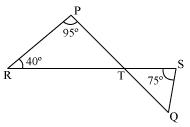
 PRT = 40�,
PRT = 40�,  RPT = 95� and
RPT = 95� and  TSQ = 75�, find
TSQ = 75�, find  SQT.
SQT. 
Solution 4
Using angle sum property for  PRT, we have
PRT, we have
 PRT +
PRT +  RPT +
RPT +  PTR = 180�
PTR = 180�
40� + 95� + PTR = 180�
PTR = 180�
 PTR = 180� - 135�
PTR = 180� - 135�
 PTR = 45�
PTR = 45�
 STQ =
STQ =  PTR = 45� (vertically opposite angles)
PTR = 45� (vertically opposite angles)
 STQ = 45�
STQ = 45�
By using angle sum property for STQ, we have
STQ, we have
 STQ +
STQ +  SQT +
SQT +  QST = 180�
QST = 180�
45� + SQT + 75� = 180�
SQT + 75� = 180�
 SQT = 180� - 120�
SQT = 180� - 120�
 SQT = 60�
SQT = 60�
 PRT, we have
PRT, we have PRT +
PRT +  RPT +
RPT +  PTR = 180�
PTR = 180� 40� + 95� +
 PTR = 180�
PTR = 180� PTR = 180� - 135�
PTR = 180� - 135� PTR = 45�
PTR = 45� STQ =
STQ =  PTR = 45� (vertically opposite angles)
PTR = 45� (vertically opposite angles) STQ = 45�
STQ = 45�By using angle sum property for
 STQ, we have
STQ, we have STQ +
STQ +  SQT +
SQT +  QST = 180�
QST = 180� 45� +
 SQT + 75� = 180�
SQT + 75� = 180� SQT = 180� - 120�
SQT = 180� - 120� SQT = 60�
SQT = 60�
Question 5
In the given figure, if PQ  PS, PQ || SR,
PS, PQ || SR,  SQR = 28� and
SQR = 28� and  QRT = 65�, then find the values of x and y.
QRT = 65�, then find the values of x and y. 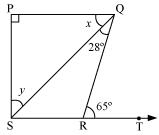
 SQR = 28� and
SQR = 28� and  QRT = 65�, then find the values of x and y.
QRT = 65�, then find the values of x and y. 
Solution 5
Given that PQ || SR and QR is a transversal line
 PQR =
PQR =  QRT (alternate interior angles)
QRT (alternate interior angles)
x + 28� = 65�
x = 65� - 28�
x = 37�
By using angle sum property for SPQ, we have
SPQ, we have
 SPQ + x + y = 180�
SPQ + x + y = 180�
90� + 37� + y = 180�
y = 180� - 127�
y = 53�
x = 37� and y = 53�.
 PQR =
PQR =  QRT (alternate interior angles)
QRT (alternate interior angles)x + 28� = 65�
x = 65� - 28�
x = 37�
By using angle sum property for
 SPQ, we have
SPQ, we have SPQ + x + y = 180�
SPQ + x + y = 180� 90� + 37� + y = 180�
y = 180� - 127�
y = 53�
x = 37� and y = 53�.
Question 6
In the given figure, the side QR of  PQR is produced to a point S. If the bisectors of
PQR is produced to a point S. If the bisectors of  PQR and
PQR and  PRS meet at point T, then prove that
PRS meet at point T, then prove that  QTR=
QTR=
 QPR.
QPR. 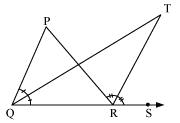
 PQR is produced to a point S. If the bisectors of
PQR is produced to a point S. If the bisectors of  PQR and
PQR and  PRS meet at point T, then prove that
PRS meet at point T, then prove that  QTR=
QTR=
 QPR.
QPR. 
Solution 6
In  QTR,
QTR,  TRS is an exterior angle.
TRS is an exterior angle.

 QTR +
QTR +  TQR =
TQR =  TRS
TRS
 QTR =
QTR =  TRS -
TRS -  TQR (1)
TQR (1)
For PQR,
PQR,  PRS is external angle
PRS is external angle 
 QPR +
QPR +  PQR =
PQR =  PRS
PRS  QPR + 2
QPR + 2 TQR = 2
TQR = 2 TRS (As QT and RT are angle bisectors)
TRS (As QT and RT are angle bisectors)
 QPR = 2(
QPR = 2( TRS -
TRS -  TQR)
TQR)
 QPR = 2
QPR = 2 QTR [By using equation (1)]
QTR [By using equation (1)]
 QTR =
QTR =  QPR
QPR
 QTR,
QTR,  TRS is an exterior angle.
TRS is an exterior angle. QTR +
QTR +  TQR =
TQR =  TRS
TRS QTR =
QTR =  TRS -
TRS -  TQR (1)
TQR (1)For
 PQR,
PQR,  PRS is external angle
PRS is external angle  QPR +
QPR +  PQR =
PQR =  PRS
PRS  QPR + 2
QPR + 2 TQR = 2
TQR = 2 TRS (As QT and RT are angle bisectors)
TRS (As QT and RT are angle bisectors) QPR = 2(
QPR = 2( TRS -
TRS -  TQR)
TQR) QPR = 2
QPR = 2 QTR [By using equation (1)]
QTR [By using equation (1)] QTR =
QTR =  QPR
QPR
No comments:
Post a Comment